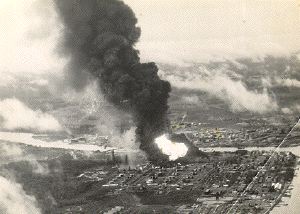![]() The Pacific War Online Encyclopedia
The Pacific War Online Encyclopedia
|
| Previous: Palawan | Table of Contents | Next: Palm Springs |
Palembang (104.774E 3.009S) was the capital of Sumatra and was located in what was then the richest known oil field in southeast Asia. Production began in 1907 and by 1940 had reached 30 million barrels a year, almost half the total for the entire Netherlands East Indies. The Pladjoe refinery produced considerable quantities of gasoline from the local light petroleum and would eventually provide 22% of Japan's fuel oil and 78% of her aviation gasoline. The city could be reached by small oceangoing vessels via the Musa River, which was the usual means of oil delivery.
The population in 1941 was about 108,200 persons.
The town was defended by a battalion of troops equipped with
an unusually large
allotment of heavy weapons. Some sources indicate that six
battalions were in the area by the time of the Japanese attack, on 14
February 1942; these may have included militia
units mobilized after
war broke out. The were also two airstrips in the area: P1 airstrip
was eight miles (13 km) to the north while P2 airstrip was 40
miles (64 km) south-southwest. Each airstrip had just two 40mm antiaircraft
guns. The airstrips initially operated Dutch aircraft in support of Singapore, but eventually the
remnants of the British and
Australian air squadrons at
Singapore fell back to Palembang along with over 3000 air personnel.
Battle of
Palembang. By 6 February 1942, the Dutch were aware that Palembang was a likely target for invasion, with reconnaissance flights showing Japanese naval forces concentrating near the Anambas Islands (105.667E 3.1N) and agents in French Indochina reporting the presence of a Japanese airborne division. The Japanese seized Muntok on 13 February and an Allied combined strike force sailed to intercept the invasion convoy the next day. However, the Allied force was sighted by a Japanese seaplane on the morning of 15 February and subject to such severe air attack that Doorman was forced to withdraw.
By then the Japanese had already begun their operation. The initial Japanese attack on Palembang was by 360 paratroops from 1 Parachute Regiment, which
dropped on 14 February 1942 and seized P1 airfield and the refinery.
An additional 100 paratroops landed the next day and Palembang was
occupied by nightfall. On the 16th the paratroops were joined by the
main body of 229 Regiment plus a battalion
from 230 Regiment coming by barge up the Musi River. The parachute operation was planned with assistance from Nakano School, who conducted extensive open source studies on Palembang, studied prewar aerial photographs of the area provided by Mitsui, and visited the Japanese fields at Niigata to familiarize themselves with the industry. Six Nakano specialists jumped with the paratroops, including one in the first wave.
The Japanese established three prisoner of war camps in the area. In May 1944 the commander of Soengei Geru Camp, Nakai, ignored pleas by a British naval surgeon to build isolation wards for a number of patients who had come down with dysentery. As a result, the disease spread throughout the camp. The prisoners particularly despised Ito, the ration sergeant, who stole the prisoners' Red Cross parcels and clothing to sell at brothels in Palembang. Ito frequently stated that the deaths of all the prisoners would mean that the camp guards could go home. Prisoners were sometimes punished by being confined in a 6' by 4' (2m by 1.5m) barbed wire cage built on top of a red ant's nest. A Dutch soldier who had suffered mental collapse was confined without food and water until he perished.
The Musa River was mined by B-29s on 10/11 August 1944, but to little effect.

Fleet
Air Arm Archive. Fair use may apply.
Operation MERIDIAN.
On 24 January 1945, British
carrier aircraft struck at
Palembang. The strikes were repeated five days later. These succeeded
in reducing production by 75%.
References
Craven and Cate (1947; accessed 2011-6-25)
Fleet Air Arm Archive (accessed 2010-2-6)
Hansell (1986; accessed 2011-6-25)
Russell
(1958)
Van
Royen and Bowles (1952)
The Pacific War Online Encyclopedia © 2006-2007, 2009-2011, 2014-2015 by Kent G. Budge. Index